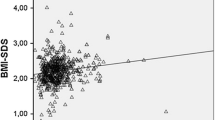Abstract
Objective
To assess the progression of thyrotropinemia to overt hypothyroidism in overweight and obese children.
Methods
150 overweight and obese children aged 5–15 years were enrolled. Free T4 and thyroid stimulating hormone (TSH) were done at enrollment and for those with TSH >5 mIU/L, TSH levels were repeated after 1 year.
Results
The mean (SD) body mass index (BMI) and TSH were 23.8 (3.19) kg/m2 and 2.70 (2.44) mIU/L, respectively. 17 children had thyrotropinemia (TSH between 10–15mIU/L); 10 (84.6%) of these children attained normal TSH levels at one year follow-up, and none progressed to overt hypothyroidism (TSH >15 mIU/L).
Conclusion
Levels of 5–15 mIU/L are common in asymptomatic overweight and obese children. Majority of these children revert back to normal TSH levels on follow-up.
Similar content being viewed by others
References
Ministry of Health and Family Welfare (MoHFW), Government of India, UNICEF andpopulation Council, 2019. Comprehensive National Nutrition Survey (CNNS) National Report, New Delhi. Available from: https://www.popcouncil.org/uploads/pdfs/2019RH_CNNSreport.pdf. Accessed January 6, 2020.
Shriraam M, Sridhar M. Subclinical hypothyroidism in children. Indian Pediatr. 2014;51:889–95.
Marwaha RK, Tandon N, Desai A, et al. Reference range of thyroid hormones in normal Indian school-age children. ClinEndocrinol. 2008; 68:369–74.
Marwaha RK, Tandon N, Garg MK, Ganie MA, Narang A, Mehan N, et al. Impact of body mass index on thyroid functions in Indian children. ClinEndocrinol. 2013;79:424–8.
Thiagarajan S, Arunbabu T, Balaji R. Subclinical hypothyroidism in obese South Indian children. Indian J Pediatr. 2019;86:662.
Longhi S, Radetti G. Thyroid function and obesity. J Clin Res Pediatr Endocrinol. 2013;5:40–4.
Aypak C, Turedi O, Yuce A, Gorepelioglu S. Thyroid-stimulating hormone (TSH) level in nutritionally obese children and metabolic co-morbidity. J Pediatr Endocrinol Metab. 2013;26:703–8.
Reinehr T, de Sousa G, Andler. Hyperthyrotropinemia in obese children is reversible after weight loss and is not related to lipids. J Clin Endocrinol Metab. 2006;91: 3088–91.
Wasniewska M, Corrias A, Aversa T, Valenzise M, Mussa A, De Martino L, et al. Comparative evaluation of therapy with L-Thyroxine versus no treatment in children with idiopathic and mild subclinical hypothyroidism. Horm Res Paediatr. 2012;77:376–81.
Khadilkar V, Yadav S, Agrawal KK, Tamboli S, Banerjee M, Cherian A, et al. Revised IAP growth charts for height, weight and body mass index for 5- to 18-year-old Indian children. Indian Pediatr. 2015;52:47–55.
Jonklaas J, Bianco AC, Bauer AJ, Burman KD, Cappola AR, Celi FS, et al. Guidelines for the Treatment of Hypothyroidism: Prepared by the American Thyroid Association Task Force on Thyroid Hormone Replacement. Thyroid. 2014;24:1670–751.
Ghergherehchi R, Nazanin H. Thyroid hormonal status among children with obesity. Ther Adv Endocrinol Metab. 2015;6:51–5.
Jin HY. Prevalence of subclinical hypothyroidism in obese children or adolescents and association between thyroid hormone and the components of metabolic syndrome. J Paediatr Child Health 2018;54:975–80.
Sridhar M, Mahadevan S, Vishwanathan L, Subbarayan A. Subclinical hypothyroidism: A prospective observational study from Southern India. Indian Pediatr.2014;55:219–21.
Matusik P, Gawlik A, Januszek-Trzciakowska A, Malecka-Tendera E. Isolated subclinical hyperthyrotropinemiain obese children: Does levothyroxine (LT4) improve weight reduction during combined behavioral therapy? Int J Endocrinol. 2015;2015:792509.
Acknowledgement
Mrs Poovitha, Statistician, Indira Gandhi Medical College and Research Institute, Puducherry, India.
Funding
None
Author information
Authors and Affiliations
Contributions
ST,AT: conceived the study; ST, RB: collected data and managed the cases; ST,RB: reviewed the literature and drafted the initial version of the manuscript; AT contributed to literature review and critically revised the manuscript. All authors contributed to drafting of the manuscript and approved the final version of the manuscript.
Corresponding author
Ethics declarations
Institute Ethics committee IGMC&RI, Puducherry; No. 06/IEC/IGMC&RI/F-7/2018 dated June 6, 2018.
Additional information
Competing interests
None stated.
Rights and permissions
About this article
Cite this article
Thiagarajan, S., Babu, T.A. & Balaji, R. Progression of Thyrotropinemia in Overweight and Obese Children From Puducherry, India. Indian Pediatr 57, 907–909 (2020). https://doi.org/10.1007/s13312-020-1991-7
Received:
Revised:
Accepted:
Published:
Issue Date:
DOI: https://doi.org/10.1007/s13312-020-1991-7




